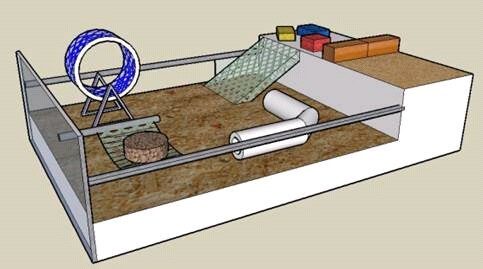Associate Professor Avi Avital from the Faculty of Medicine at the Technion trains rats to identify explosives and uses them to build a working model for the treatment of diseases such as schizophrenia

Associate Professor Avi Avital, from the Rappaport Faculty of Medicine at the Technion, trains rats. Through them he builds (with professors Moshe Gabish and John Finberg) - a working model for the treatment of neurodegenerative diseases of the brain such as Parkinson's and Huntington's. Recently, he even built a valid working model for the symptoms of schizophrenia: "We gave them ketamine (veterinary anesthetic) in a low dose and exposed them to stress, thus we built a working model for the treatment of schizophrenia - an understanding of the plot factors for the outbreak of the disease and an experimental platform for the development of a drug."
In an applied study, Associate Professor Avital was able to train rats to find explosives. "Rats have a much more developed sense of smell and we were able to train a thousand rats to find explosives," he says. "The insights from a study in a rat model are applied to working dogs in a study that takes place in collaboration with the Ministry of Defense and the US Army".
"In an extensive mapping study we conducted, we exposed rats to stress at different times during their lives and found that the critical period for exposure to stress is the period corresponding to the transition from childhood to adulthood in humans," he says.
Thanks to a grant from the NIH and the US Department of Defense, Associate Professor Avital built a sophisticated laboratory for behavioral biology, where he examines rats mainly in the field of attention and social cooperation, while combining behavior with physiological and pharmacological research. At the same time as he conducts clinical research at the "Haemek" medical center in Afula, he does not neglect the dogs. He recently developed a gauze pad that simulates an explosive (absorbs the vapors of the explosive) as a systematic and safe means of training dogs. In this field, he recently proved the importance of the relationship between the level of stress and attention of the handler and the dog's performance ability. In addition, it was found that if the dog recognizes one type of explosive, it will be able to generalize and identify other types as well. According to the work plan he built, within two weeks a Belgian shepherd dog can be trained to locate different types of explosives. "We showed that this generalization is in the same area in the brain of dogs and rats," he says.
Associate Professor Avital developed an ability to control rats through behavioral design. He dresses the rats in a "vest" connected to small metals that are implanted under the rats' skin, without any pain. The rat felt a light pat and he taught it that when the pat is on the right side - it should turn to the left, and vice versa. When the pat on both shoulders - she will stop.
In the field of social cooperation research, Associate Professor Avital built a maze controlled automatically by software and a camera through which the rats learn social cooperation. "Females are better at cooperation than males", he emphasizes.
Associate Professor Avital's work is unique in that, beyond translational science (careful extrapolation from a rat model to humans), he also performs semi-translational science, that is: from one animal (rat) to another (dog).

5 תגובות
Joseph
In the mammal department there is the series of the bivalves, and the two sub-classes marsupials, and the placental animals.
There is no such concept as a "missing link" in evolution - most species are missing, and not a small minority that can be called "missing links".
Medical and non-cognitive experiments. Whether the rat is smart does not affect medical behavior.
Mammals have been around for more years than the extinction of the dinosaurs. 165 million years ago, the beginning of the dinosaurs. The mammals are somewhere in the middle, a missing link in the name of a marsupial duck, a mammal, laying eggs - its origin is probably between 165 million and now.
Joseph
Mammals have existed for over 200 million years. I think a lot is done secretly in rats because of their high intelligence. They are relatively distant genetically from humans.
The rat is not a stupid animal even if it is seen in our eyes as despicable and we do not want to see live rats and rats in general.
Our ancestor 65 million years ago and of all terrestrial mammals is a rodent mammal measuring a few centimeters.
The fact that a rat is used in research probably indicates, in my opinion (I'm not an expert), a sufficiently close genetic relationship.
There is a professor with an Argentinian accent at Tel Aviv University who has developed a second generation commercial chip, with carbon tubes for example, that detect explosives. Not only that, diseases too. And it works. An article was published not now in nature comm,